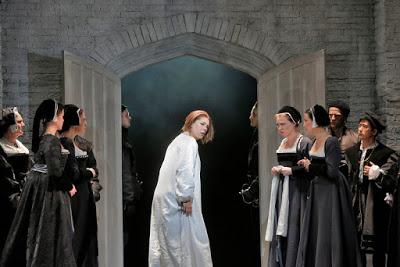Sondra Radvanovsky takes on Donizetti's Anna Bolena.
by Paul J. Pelkonen

Sondra Radvanovsky (center, in white) faces madness and her own fate in the last
scene of Donizetti's opera Anna Bolena.
Photo by Ken Howard © 2015 The Metropolitan Opera.
Anna is a slightly fictionalized version of the very real downfall of Anne Boleyn, who was eliminated by Henry after he fell in love with her courtier Jane Seymour. It is Anne's crisis that forms the plot of this opera: her unhappy marriage to the brutish King, her secret past love affair with Richard Percy and the discovery that her friend Jane (here, Giovanna) Seymour is her rival and soon, her successor. This production by Sir David McVicar is much the same as its premiere, an example of the New Met Style with bare sets, oppressive walls and shifting acting spaces that make maximum use of the house's remarkable backstage machinery.
The primary challenge for any bel canto singer is the exposed nature of the vocal line. The voice carries everything here, often against minimal orchestral accompaniment. This allows the singers to make their own statements, but the lack of an orchestral cushion makes every aria and cabaletta something of a high wire act. Donizetti was entering his mature period with this opera, and his writing goes from stolid to florid, with the singers given room to create as the emotional temperature of the drama reached a boiling point.
Ms. Radvanovsky was in excellent voice here, with a powerful, mezzo-like low register, smooth navigation through the passagio and an upper range that could be called upon for ornamental acrobatics high above the stave. As Anna's fate is sealed her distress grows, expressed in more and more elaborate vocal writing. This culminated in an enormous, multi-sectioned mad scene in the Tower of London in which the Queen loses her reason on the way to the executioner's block.
In this scene, staged with the Met elevator halfway up and the looming walls of the Tower of London overhead. Ms. Radvanovsky marshaled her resources, painting a dimensional and demented portrait of the Queen at the end of her reason. She sang the fiery "madness" sections with gusto but also let the watcher hear her genuine distress in the moments when her reason slips back into place and she realizes that her execution is imminent.
Henry married Jane Seymour just eleven days after Anne's death. Here, this key role was sung by mezzo Jamie Barton, a fast-rising star and a late replacement for the indisposed Elina Garança. Ms. Barton was tremendous in this ungrateful part: she plays her part in destroying Anne but is also a victim of Henry's manipulations. Their scena together at the start of Act II provided some of the evening's best entertainment, as they whizzed through a propulsive dialog that was more Shakespearean than operatic.
Ildar Abdrazakov reprised his Henry from a few seasons back, playing the villain with gusto and a big, dark tone. In support, tenor Stephen Costello was strong in the early going as Percy. However the big moments in the Act II aria "Vive tu" came off as shaky and at best, uncertain. Mezzo Tamara Mumford took the role of courtier Mark Smeaton, whose obsession with Anne inadvertently causes her demise. Baritone David Crawford and tenor Gregory Schmidt were solid in their smallish roles. The Met chorus sang magnificently, although the orchestra (under the baton of Marco Amiliato
sounded as if they wished they had more exciting music to play.

